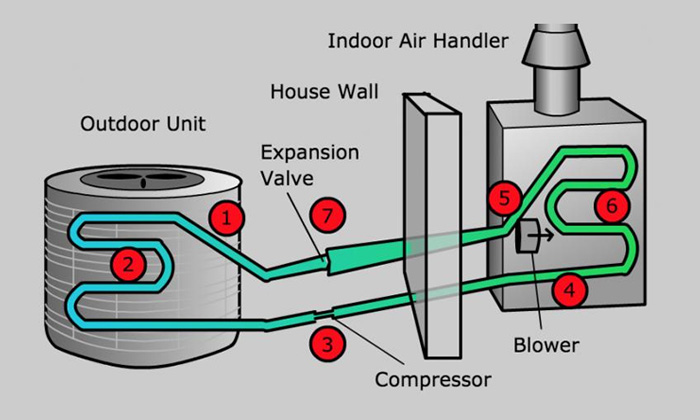Electrical energy can be converted into heat, another form of energy. Latent energy in natural gas can be converted into heat through combustion. This is how we typically heat our homes. The electrical conversion is 100% because there is nowhere else where the heat can go, but gas furnaces vary in efficiency, but it’s less than 100%.
But not a heat pump. A heat pump is an amazing device that does not create heat but rather transfers it from one place to another. Because of this a heat pump can be much more than 100% efficient. A measure of its efficiency is called the coefficient of performance (COP). A heat pump can have a COP of 2-5 which means that for every Kw of energy you put in, the heat pump will give you 2-5 Kw out. That’s amazing!
Although it is called a heat pump it can both heat and cool. The cooling efficiency is even better than the heating efficiency of a heat pump. And the technology is improving. The new versions of the heat pump can heat even at minus 25-30 degrees Celsius so you can almost replace your furnace and certainly your air conditioner with one unit that is 2-5 times more efficient. Even though the extreme cold has seemed endless, there have been only 11 days below minus 25 Celsius this winter (till January 10, 2022). On those days the heat pump would be very inefficient or not work at all meaning that you should still need a backup for heating on those coldest of days.
There are several configurations of heat pumps. There are two major categories: ground source, also called geothermal and air source. I have focused on the air source category here. Air source heat pumps can be ducted into the regular air duct system of your house or you can have ductless systems if you are replacing baseboard heaters and do not have a duct system in your house. Air-air would be one configuration where you draw the heat from the outside air and deliver it to an inside unit that has a fan to blow the heated air into your rooms. Air-water units would draw air from the outside and transfer the heat to a water heater perhaps connected to a floor heating system.
In terms of total energy required to heat a typical home, a ground source heat pump uses the least amount of energy, estimated at $597 per year (Manitoba Hydro cost comparison estimates November 2021). The second cheapest is a high efficiency natural gas furnace at $802 per year, however it produces greenhouse gases. I checked my Manitoba Hydro bill and the natural gas price now in January 2022 is $0.448 per cubic meter, up from $0.308 per cubic meter, the price Hydro used in its calculations. This changes the cost of a natural gas furnace to $1166 per year. The third (actually the second best with updated prices because electricity costs have not changed since November 2021) in terms of least energy required is a cold climate (works to minus 25-30 degrees Celsius) air source heat pump at $994 per year. An electric furnace or baseboard electric heaters would cost $1492 per year to heat that same home. To make the air source heat pump even more financially attractive you may apply for a Federal Greener Homes Grant of up to $5000 with an additional $600 to pay for the energy audit you will need to be eligible for the grant. That $5000 grant will probably cover approximately half of the cost of purchase and installation of an air source heat pump.
And remember, the air source heat pump will also provide air conditioning for that same price.
The air-air heat pump is still considered novel, but it seems to me its time has come.




